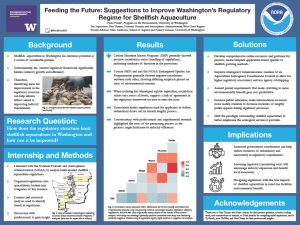Feeding the Future: Suggestions to Improve Washington’s Regulatory Regime for Shellfish Aquaculture
Shellfish aquaculture has immense potential for large scale, low environmental impact food production. However, a complex and restrictive regulatory framework greatly hinders industry efficiency by imposing a variety of costs. The purpose of this study was to evaluate the multileveled body of regulations for shellfish aquaculture within Washington to identify issues and suggestions for improvement. I worked with the National Oceanic and Atmospheric Administration (NOAA) to analyze Shoreline Master Programs for selected counties, the Washington Administrative Code, the Army Corps of Engineers’ Nationwide 48 permit, as well as the NOAA Endangered Species Act Programmatic. I categorized regulations into spreadsheets based on areas of environmental concern (e.g. water quality) and performed a content analysis on the specific language used; the results were inputted into RStudio for statistical analysis. To supplement this, I conversed with industry professionals who provided insight into firsthand experiences working under the current regime. Findings from my analysis indicate positively correlated trends between most county level regulations, meaning they tended to handle regulations similarly, negatively correlated trends between many county and federal level regulations, meaning they tended to place emphasis differently, with the permitting process presenting itself as the greatest single hindrance to industry efficiency. Our identification of these trends in similarity concerning the treatment of key environmental concerns can be applied to known troublesome areas of regulation to suggest modification. Furthermore, identifying the grievances and associated costs of the permitting system lends to suggestions for modified agency communication and other measures to reduce the permitting load.
